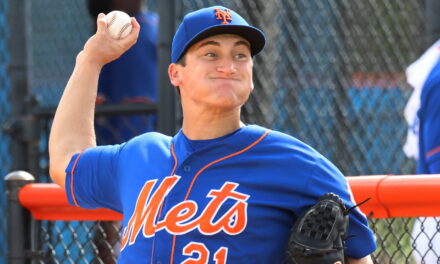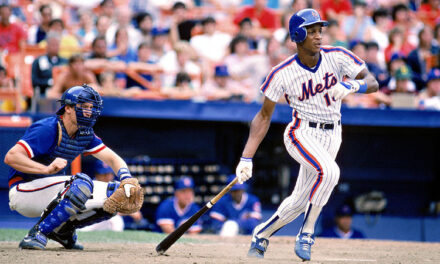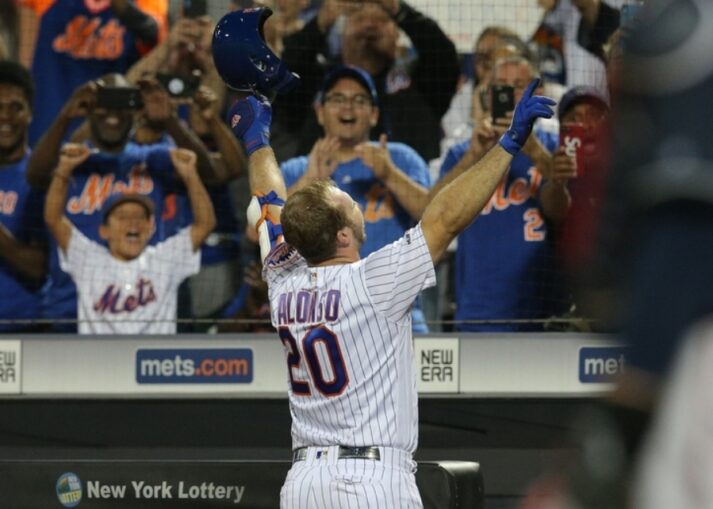
Former Mets’ area scouting supervisor Jon Updike believes in paying it forward.
As a former 28th-round pick by the Seattle Mariners in the 1993 MLB Draft, Updike reflects fondly on the scout, John Ramey, who took the chance on him as a reliever and offered Updike all he could ask for: an opportunity.
After his professional playing career was over, in which he spent time with the Mariners, Milwaukee Brewers and Texas Rangers organizations, Updike transitioned into a college baseball coach in Florida. The connections and relationships Updike built in Florida led him back to professional baseball, where the New York Mets hired him as their area scouting supervisor in North and Central Florida in 2014.
Updike’s new career offered him the chance to afford opportunities to young players, just as Ramey had done more than two decades prior for him.
The life of a scout includes logging a ton of miles on the road while traveling from game to game, building relationships with coaches, players and families, and doing extensive scouting work on why a particular player should merit an organization to sign him.
While scouting can often be a thankless job, remaining in the background while the talent they scouted and signed hopes to see their dreams imagined, Updike’s name was often mentioned throughout the 2019 season.
That’s because one of the players he signed back in 2016 burst onto the scene, surpassing Aaron Judge for the single-season rookie home run record while becoming the sixth Met to win Rookie of the Year: Pete Alonso.
Part of Updike’s job as a scout was to not only identify tools and projections, but to also assess a player’s work ethic and makeup. Those traits stood out for Updike when he was scouting Alonso, as he saw a player that not only had the talent, but composure to handle the large media market that is New York.
In last year’s draft, Updike was responsible for signing Matt Allan out of Seminole High School in Sanford, Florida, in the third round. The right-handed pitcher was considered to be a potential first-round talent on many draft boards but fell with concerns of his asking price, along with his commitment to the University of Florida.
The Mets restructured their draft and were able to save money from their draft pool by signing college seniors in rounds four through ten for below-slot bonuses to help meet Allan’s demands.
This past November, SNY’s Andy Martino reported that Updike left the organization to begin his next chapter as President of Digital Scouting and Player Development Solutions for BaseballCloud, a software company that offers technical, data-driven solutions for players and clubs.
BaseballCloud digests in-game metrics from multiple technologies and accessories and is then presented in a way that’s easy to understand in order to track progress and areas for a player to work on.
BaseballCloud was designed for players and coaches as an easy to read development tool which allows users to store and track their data and progress. That tracking of progress is what Updike refers to as player mapping. The analysis BaseballCloud provides allows players and coaches to view their data with 3D visualizations and graphics that are easy to grasp and utilize for a player’s development.
The hope is that BaseballCloud allows for more impact on the development of amateur players; getting them more accustomed to the data and metrics while consistently tracking their progress using their revolutionary software.
Updike’s new occupation incorporates his extensive scouting background with analytics to provide custom visualization tools that transform how data is used at the amateur levels.
While he’s no longer affiliated with a specific Major League organization, Updike now has the chance to impact even more young athletes hoping for the chance to one day make it professionally.
He hopes the software will help propel amateur players to reach even more of their potentials while providing them with all he could ask for in his own professional playing career, and what he afforded to many players in the Mets organization: an opportunity.
I had the privilege of speaking with Updike this past December where he talked about his life as a scout and new role with BaseballCloud. This interview has been split into two parts given it’s length.
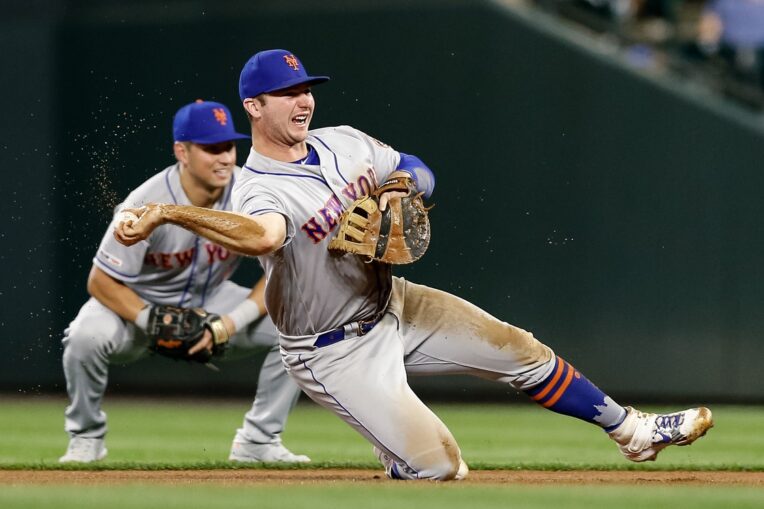
MMO: Can you talk about BaseballCloud and your role with the company?
Updike: I’m the President of Digital Scouting and Player Development Solutions. What that really means is we’re basically a software company; we digest the in-game capture which would be at the professional level Trackman, FlightScope and Yakkertech. We’re working right now with Hawkeye and the accessory technologies like bat sensors, biometric sensors and camera vision.
We’re the people that can blend the technology and we’re working at creating solutions to what the tech or the metrics means from a player development and player identification value standpoint.
MMO: Your background is in scouting, and fans have long heard about the old guard vs. new guard when it comes to baseball decisions. Have you been interested in and utilized analytics in your work for some time now?
Updike: Yeah. I have a playing background and I’ve kind of touched on everything as a player and coach. It’s part of our game in scouting and player acquisition.
I think sometimes the narrative and impression of our game is every major league club has an analytics and R&D department. But there are 30 clubs and there’s still a first-place and last-place club. Just because you have it doesn’t mean it’s going to make you good. You have to understand the information, digest it, understand just not how to apply it but how to use it to get players better.
We’re the largest provider of software solutions to Division I programs. I come from a scouting standpoint and understand where they’re at from a player’s standpoint because we were scouting the players. But what are the universities doing from a technology standpoint? Major League Baseball uses the technology first in an evaluative process, so that you can value and evaluate the player. But it’s also from a player acquisition standpoint, it’s financial. That’s why a lot of technology exists, so they can make better financial decisions.
That’s not the main goal at the collegiate level. The main goal is to develop better players. It’s also a smaller group of players that they have to deal with, so you’re able to grow a player to your coaching and technological philosophy over a four-year period, which is a really unique study.
We have some schools that we partnered with and it’s amazing. I’m a scout, so I like to group things and I’m a maker of lists. It’s like the Niña, Pinta and Santa Maria. There are clubs that are on the first boat and the advantage of being there is you get off and you’ve got the lay of the land. You get to pick what you want and you’re the leader. But along with that comes the risk of errors.
The majority, and what we’re seeing in professional baseball, is that second group. They’re going to adapt and we’re seeing it with a lot of the hirings on the player development end. It’s not that they want pushback or they don’t want to do it, but it’s got to be a good financial decision but secondary to that is they don’t want to be wrong.
The truth is we’re still in the third inning. The machines are incredible but they’re adapting in proving accuracy issues. There are questions to what a lot of the information means, because now we’re going from game metrics to biometrics and quite honestly, we’re not doctors. With the new technology, it’s going to be this plethora of information and once again, how are you going to use it? Is it going to be evaluative? Or, is it going to be used for developmental purposes?
Our main goal is to aid in steering it toward development and maximizing that aspect of it. But the same thing, as technology becomes more affordable and there are more machines out there to gather information on players, our job and our software at BaseballCloud digests it all. What we’re able to do is track a player, not just for a singular at-bat, but a track a player over time.
We see a time where a seven-year-old goes and buys his first bat because there’ll be swing sensors in every bat probably within the next three years. The player registers and from the time he’s seven every league and tournament he plays in, all of that info that we’re able to capture on that player feeds into one place. It creates the story of that player and allows for interaction, which for us, is a unique approach for growth. It’s the mapping of the player and their story.
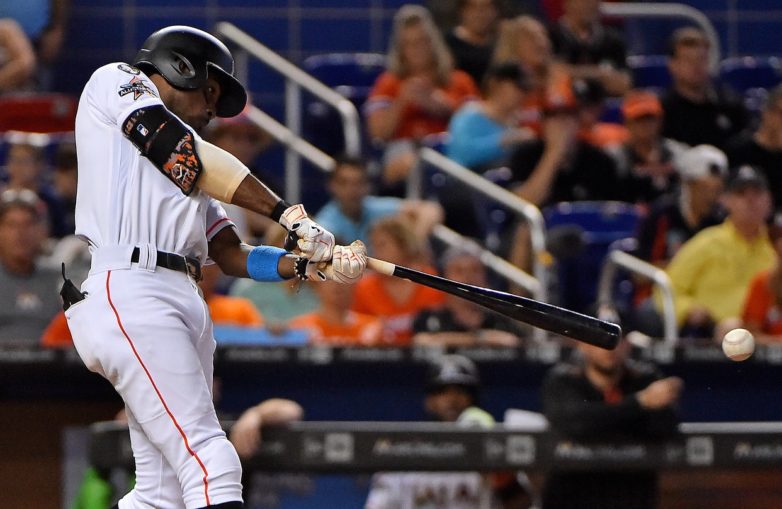
MMO: How did you become a scout with the Mets?
Updike: I was a junior college coach in Florida, and junior college baseball in Florida is the best in the country. They have tremendous players and a lot of the programs have produced many major league players as most Division I schools or more.
I had several major league players: Dee Gordon, Mike Clevinger and Brett Oberholtzer. We had tremendous players that we were able to work with.
For me and my playing career, I ended up playing at a junior college in Florida and it was a wonderful route to go. There’s a lot of networks that we have at that level because you’re dealing a tremendous amount with professional clubs, and also dealing with universities. It was just a natural fit.
The opportunity came from the Mets, and I had seen a million kids and you’re on the road a lot traveling and scouting. It’s a lot of sacrifice from that standpoint, and I needed to be at a point where my kids were old enough for me to be able to be away. The Mets were wonderful in the area that I had and I did get home every night. And that meant a lot. So we decided to go that route.
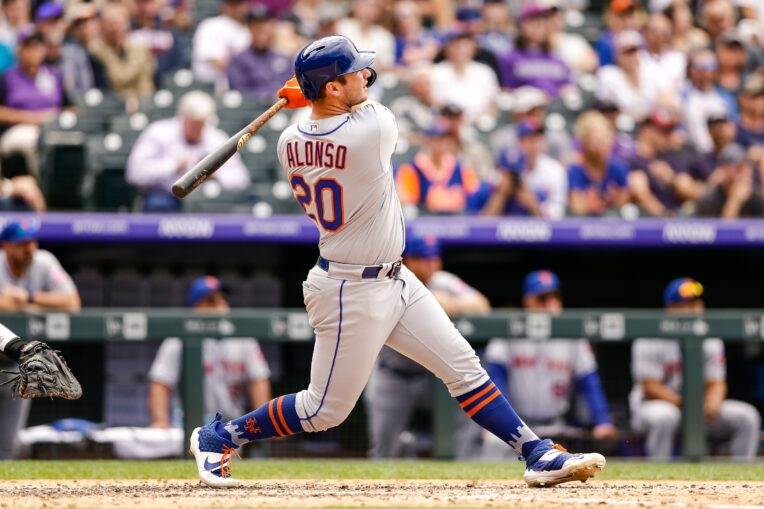
MMO: You signed Pete Alonso back in 2016. Can you talk about what you saw from Alonso early on, and just the overall process of scouting him?
Updike: Pete’s a tremendous story. At the end of the day, from a scouting perspective, our job is to scout and evaluate tools. With Pete, he has an eighty tool. When we scout amateur players the first thing we’re looking at are tools. He has a double plus tool with power.
You identify tools and everybody understood that the kid could hit the ball a country mile, but what type of individual is this going to be? What type of work ethic does he have? How easily is he going to be able to adapt? Specifically, in our case, where the Mets have to take into consideration that this kid’s going to play on the largest stage in the world and in one of the craziest media markets. Is he going to be able to handle it?
Throughout the history of the Mets organization, there’s been some guys who haven’t been able to handle it. That’s where the makeup aspect becomes so important. And even for us in the scouting process, obviously, we have checks and balances of how we identify the players. At the end of the day, we have to be the experts in the industry on that player to pull the trigger and make those kind of commitments for a player that’s taken in that spot. Matt Allan kind of shadows that as well.
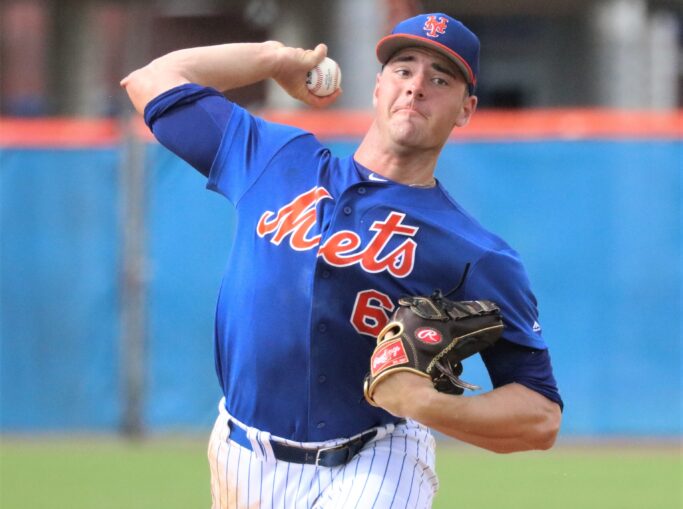
Matthew Allan/Photo by Ed Delany, MMO
MMO: Can you talk about scouting and eventually signing Matt Allan? With Allan being advised by Scott Boras, and with leverage of going to school if he didn’t get his target bonus, why were you so sure Allan was going to sign?
Updike: He moved from California to Florida and came on the scene. Guys who play in Florida have the highest density of talent in the country. From Tampa to Orlando up to Jacksonville, that’s what my job was; to understand everything that happened in that area.
With Matt, he’s a tremendous athlete. As he progressed, there’s something that you see that grabs your attention.
Once again, it takes a village to acquire a player. A good friend of mine and former Met, John Hendricks, was a pitching coach at Wake Forest and had a relationship with this kid. John had a relationship with him because he worked with USA Baseball and was able to be in the dugout with him as a pitching coach and we would share information.
I was able to spend time with Matt and express to him not just that you’re a good kid and we’re scouting you and some of the base things, it was really pitching the idea of what we were capable of doing from the development of pitchers, our history of it, guys we have at the big league level and the players that we’ve acquired through the draft and the minors that are superseding expectations.
This is what pitchers will be in the future from the high school perspective. There wasn’t a deep development or a lot of projection with it, he already had full understanding. He was our level of comparison, we’re not scouting the pitchers from Division I programs, the top guys in the country. I look at their work ethic, their plan, their mapping; I always think of it as player mapping. Where they’re at, where they’re going to get to, how they’re going to get there. What’s the route that they can take to the big leagues and what are the challenges that they’re going to face?
A lot of things that have to be introduced such as arm care, nutrition, throwing patterns, workloads that they have. This kid is a machine. He was on a level beyond where a lot of the college pitchers were as far as self-awareness, ability to work, and quite honestly, because of that quality plan and dedication, he was ahead of the college kids and some professional pitchers as far as awareness and commitment to the plan.
With Matt, and obviously with Orlando being such a high-density area, a kid that grows up in Central Florida, a better player will have exposure to guys that have won Cy Young Awards and being able to work out with them. The place that Matt’s working out right now, you’re in there and there’s the Mariners’ top pitching prospect working out with him. You have roughly 15 professional pitchers that roll in at nine in the morning and are grinding it out, getting their offseason work in.
It’s a mindset and he has it. That was the thing that was super appealing to me. A kid that has that level of commitment that early in his life and can express his plan, not eye-washed, but truly that you can tell this kid lives this.
From a pitching standpoint, the draft in professional baseball offers protection. It offers some financial protection. Many don’t realize that we pay for their college education, all of it. Even with me going back to the nineties, it’s how I got my education. I got done playing and now what the hell am I going to do? Well, part of my signing bonus was college. It allowed me to be a college coach and a scout and continue my life. It wasn’t you’re out of the minor leagues two years now you need to go hang the drywall. The perception is not the reality.
When you really think about it at the college level, the NCAA only allows 11.7 scholarships at the Power Five schools. Every kid that plays college baseball is paying to play college baseball, there are no free rides. If you throw a baseball for a living, you’re going to have an injury at some point. Professional baseball offers better protection for those guys, and Matt realizes that.
My belief is that not a lot of things really have to line up. He has that type of talent, work ethic and stuff to be an impact player. With that kind of player, it’s also appealing because you’re seeing now under the new models of finances in the way baseball is, it provides multiple paydays. We’re seeing great examples of that where guys are getting a quarter of billion-dollar contracts. There’s your appeal. I want to get there because I’m capable of doing this.
Matt is an elite talent that somewhere down the road could put himself in that position. It’s not just, hey, I want to be a pro player. Matt has the goal of wanting to be the best pitcher on the planet. And maybe he’s not going to come out and state things like that, but you can tell through their presence, work and ability. That’s what set me off.
You can tell. You do this long enough you can tell through their eyes. Are you excited or are you scared? This kid’s excited.
Follow Jon Updike on Twitter, @Updikej33
Learn more about BaseballCloud here. Part Two of this interview will be available later this week.



